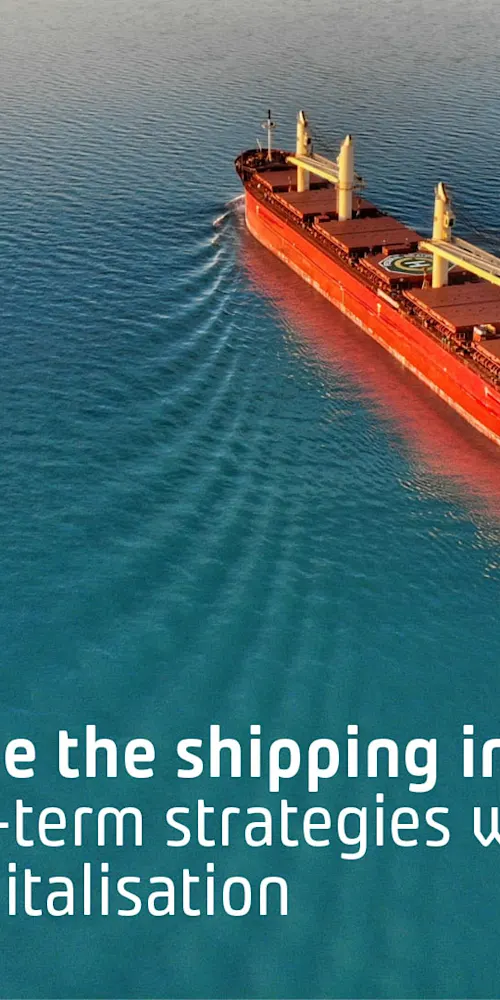Looking forward to the path ahead: short, medium and long-term steps to maritime decarbonisation (Part 2)
ZeroNorth’s new blog series examines the decarbonisation challenge in shipping and the short, medium and long-term solutions that can put us on the right path

The story so far
As we explored in last week’s blog, the issue of decarbonising the shipping industry is the central challenge of our times. We took a look at some of the initiatives and actions taking place that mark the required step change in ambition, innovation and collaboration that our sector needs to meet its targets.
We also examined the role that data can play in driving and unlocking immediate action on fuel and emissions efficiencies. We believe that turning data into actions is one of the easiest ways that we can drive progress in the near term.
In today’s blog, we explore the more medium and long-term innovations and changes that shipping may undertake on its path to net zero emissions. As we outlined in our last blog, by ‘medium term’ we mean changes that will take place towards the end of this decade and into the 2030s. And ‘long term’ will mean exciting but bold innovations that may happen in the 2030s and 2040s.
Changes in the medium term
In the last part of this series, we examined some of the ship-based energy efficiency technologies (or clean tech) that will be deployedin the very near future. One of the defining characteristics of the medium term of maritime decarbonisation is likely to be the increasing adoption of ‘advanced’ vessel designs that incorporate integrated propulsion chains and energy efficiency technologies to generate cumulative fuel savings. This most likely will be a step change in vessel design.
Meanwhile, these ‘ecoships’ will also be increasingly powered by low carbon fuels such as ammonia, methanol, biofuel and hydrogen. We will also see more innovation in clean technologies, with some more mature solutions (such as the frontrunners of air lubrication and certain types of sails) now seen as a standard for all vessels.
Most impactful of all of these factors is the development of some of the new fuels we have mentioned. It is these future fuels that will drive the bulk of decarbonisation action – but there is a downside. Many of these fuels are expected to be radically more expensive than conventional marine fuel. We will explore what this could mean later on. From a macroeconomic perspective, a changing marine fuel mix may even drive changing shipping routes and trades. Depending on which nations become future fuels powerhouses, we may see new ports springing up, and new routes becoming the norm.
From a societal perspective, we can expect to see far more scrutiny from consumers and cargo owners into activities taking place in the supply chain. That means more pressure on the shipping industry to adapt and improve its efficiency – again improving the position of solutions to reduce environmental impact.
The long-term view
As with all future-gazing, the long term can be very hazy. The amount of regulatory change – and regulatory fragmentation – that the next decade could bring makes any kind of authoritative analysis of the future hard to undertake.
However, there are some trends that we can point to. The changes to vessel design we have already highlighted in this blog will probably become even more fundamental, with huge changes to vessel design and increasingly blurred lines between key trades.
For example, one concept being explored is that of modular cargo containers for dry and wet bulk goods. This would effectively combine the two trades into one, standardising the transportation of these goods as containerisation did for consumer products.
However, this is still very speculative and it is yet to be seen whether the rest of the supply chain – and ports in particular – will adapt to this trend.
The long term will almost certainly be marked by the widespread adoption of zero carbon fuels across the majority of the global fleet. However, their lower calorific density – the amount of energy per unit stored – will mean that ships may have capacity reduced as they have to carry more fuel, or they may have to refuel more often.
All in all, the long term is difficult to predict. But what we can point to are some fundamental changes that are sure to be momentous for a sector that is used to a standard way of operating and ‘commodity’ fuels.
The role of digital efficiencies
This blog has focused on some of the operational and technical changes expected to impact shipping – and especially ship design – in the medium and long term. That is not to say, however, that no digital innovation will take place.
The future digital pathway for shipping is immensely exciting. Again, looking to the long term, the prospect of remote or fully autonomously operated ships should engage anyone who is interested in how technologies are reshaping the future of our sector.
However, it is worth raising once again the increased scrutiny being placed on our industry by outside forces. An increasingly ‘end-to-end’ supply chain will put a greater onus on ship owners and operators to transparently demonstrate the efforts they are taking to decarbonise.
Clearly, this transparency will be powered in huge part by digitalisation. In this changed context, decision to use digital technologies to generate instant emissions savings is even more obvious. That’s why ZeroNorth is excited to be part of this momentous change for shipping. Our core aim is to digitalise shipping for the climate – a mission that we are excited to continue to pioneer with our partners.
To find out more about what ZeroNorth is doing to digitalise shipping for the climate, and more about our Optimise platform, visit: www.zeronorth.com/optimise